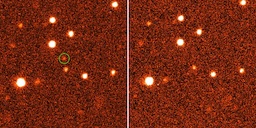RATIR was a dedicated multi-channel optical and infrared imager for the robotic 1.5-meter Johnson telescope at the Observatory Astronómico Nacional in Mexico. It was installed continuously for ten years from April 2012 to June 2022 and operated every night, subject to weather, engineering, and operational constaints.
RATIR was designed for follow-up observations of the afterglows of gamma-ray bursts (GRBs) detected by the Neil Gehrels Swift Observatory, but is also used for other science.
The images above show the fading afterglow of GRB 130327A. The image on the left was taken with RATIR 1.7 hours after the GRB was detected by Swift. The image on the right was taken about 24 hours later. The images are in the i band and are about 1.3 arcmin to a side. In the earlier image, the afterglow is clearly visible in the green circle with i ≈ 21.2. In the later image, it is no longer visible, having faded by 1.3 magnitudes or more. The afterglow was also detected and seen to fade in the r, Z, Y, and J bands. See GCN Circulars 14334 and 14352.
- Technical Information
- Using Data
- GRB Program
- Publications and Theses
- Gallery
- Participants
RATIR was a collaboration between:
- Arizona State University
- NASA Goddard Space Flight Center
- University of California Berkeley
- University of California Santa Cruz
- Instituto de Astronomía of the Universidad Nacional Autónoma de México.
and was lead by:
- Nat Butler (ASU — instrument principal investigator)
- Alexander Kutyrev (NASA/GSFC)
- William Lee (UNAM)
- Alan Watson (UNAM — telescope principal investigator).
RATIR benefited from the generous loan of a H2RG detector by Teledyne Scientific and Imaging.
